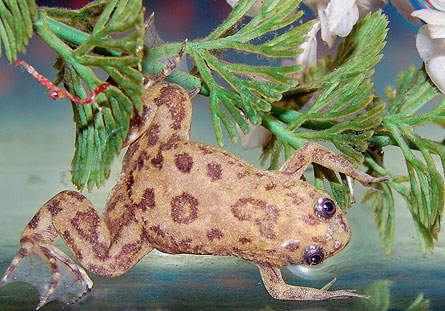When frog gender flips
With weed killer in the water, some males acquire female traits.
Several months ago, a California college student working at a university laboratory checked up on a group of frogs. And she witnessed an unusual behavior. Some frogs were acting like females. And that was unusual, because when the experiment began, all of the frogs had been males.
The student, Ngoc Mai Nguyen, says she told her boss: “I don’t know what’s going on, but I don’t think this is normal.” Nguyen is a student at the University of California, Berkeley. She was working in the laboratory of biologist Tyrone Hayes.
Hayes didn’t laugh. Instead, he told Nguyen to keep watching — and write down what she saw each day.
Nguyen had known that all the frogs had started out as males. What she didn’t know, however, was that Hayes had added something to the water of the frog tank. That something was a popular weed killer called atrazine. Since birth, the frogs had been raised in water that contained the chemical.
Hayes says the experiments in his lab show that 30 percent of the male frogs that grew up in water with atrazine started to behave like females. These frogs even sent out chemical signals to attract other males.
 |
|
When this frog species is raised in the lab in water tainted with what EPA considers acceptable concentrations of atrazine, males change — sometimes into apparent females.
|
| Furryscaly/Flickr |
Laboratory experiments are not the only places where frogs may run into atrazine. The chemical is used as a weed killer. So it can pollute surface water downstream of the crops where it has been used. In these rivers and streams, levels of atrazine can reach 2.5 parts per billion — the same concentration Hayes tested in his laboratory. This suggests that male frogs might be turning into females in their natural habitats.
The U.S. Environmental Protection Agency, or EPA, is responsible for protecting human health and the environment. EPA sets limits on how much of certain chemicals will be allowed in U.S. waterways. And EPA concluded that for atrazine, up to 3 parts per billion — well above the concentration that turned Hayes’ male frogs into females — is safe. If Hayes is right, even the EPA definition of a safe concentration is actually not safe for frogs.
Hayes and his team also showed that it’s not just the frogs’ behavior that changes after exposure to atrazine. Males raised in water containing atrazine had low levels of testosterone and did not try to attract females.
Out of 40 frogs raised in water containing atrazine, four even had high levels of estrogen — a female hormone (that’s four out of 40 frogs, or one in 10). Hayes and his team dissected two of the frogs and found these “male” frogs had female reproductive organs. The other two transgender frogs were introduced to healthy males and mated with those males. And they produced baby male frogs!
Other scientists have looked at Hayes’ work and carried out similar experiments — with similar results. Plus, researchers who study other animals have observed that atrazine affects those animals’ hormones.
At least one scientist, Tim Pastoor, says Hayes has made mistakes in his study and that atrazine is safe. Pastoor is a scientist with Syngenta Crop Protection. Syngenta is the company that makes and sells atrazine.
In an email to Science News, Pastoor wrote that Hayes’ new experiments don’t lead to the same results as Hayes’ earlier studies. “Either his current study discredits his previous work, or his previous work discredits this study,” Pastoor wrote.
It’s important to know how atrazine affects the animal population. Any chemical that can change the reproductive patterns of an animal threatens that species’ survival.







